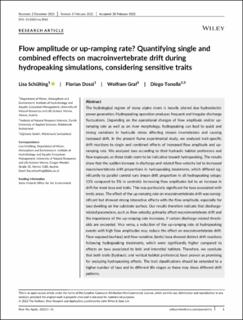Bitte benutzen Sie diese Kennung, um auf die Ressource zu verweisen:
https://doi.org/10.21256/zhaw-26617| Publikationstyp: | Beitrag in wissenschaftlicher Zeitschrift |
| Art der Begutachtung: | Peer review (Publikation) |
| Titel: | Flow amplitude or up‐ramping rate? : quantifying single and combined effects on macroinvertebrate drift during hydropeaking simulations, considering sensitive traits |
| Autor/-in: | Schülting, Lisa Dossi, Florian Graf, Wolfram Tonolla, Diego |
| et. al: | No |
| DOI: | 10.1002/rra.3963 10.21256/zhaw-26617 |
| Erschienen in: | River Research and Applications |
| Band(Heft): | 39 |
| Heft: | 3 |
| Seite(n): | 412 |
| Seiten bis: | 426 |
| Erscheinungsdatum: | 2022 |
| Verlag / Hrsg. Institution: | Wiley |
| ISSN: | 1535-1459 1535-1467 |
| Sprache: | Englisch |
| Schlagwörter: | Alpine region; Amplitude; Benthic invertebrate; Experimental flume; Hydropower; Ramping rate |
| Fachgebiet (DDC): | 333: Bodenwirtschaft und Ressourcen |
| Zusammenfassung: | The hydrological regime of many alpine rivers is heavily altered due hydroelectric power generation. Hydropeaking operation produces frequent and irregular discharge fluctuations. Depending on the operational changes of flow amplitude and/or upramping rate as well as on river morphology, hydropeaking can lead to quick and strong variations in hydraulic stress affecting stream invertebrates and causing increased drift. In the present flume experimental study, we analyzed trait-specific drift reactions to single and combined effects of increased flow amplitude and upramping rate. We analyzed taxa according to their hydraulic habitat preference and flow exposure, as these traits seem to be indicative toward hydropeaking. The results show that the sudden increase in discharge and related flow velocity led to increased macroinvertebrate drift proportions in hydropeaking treatments, which differed significantly to parallel control runs (mean drift proportion in all hydropeaking setups: 13% compared to 5% in controls). Increasing flow amplitudes led to an increase in drift for most taxa and traits. This was particularly significant for taxa associated with lentic areas. The effect of the up-ramping rate on macroinvertebrate drift was nonsignificant but showed strong interactive effects with the flow amplitude, especially for taxa dwelling on the substrate surface. Our results therefore indicate that dischargerelated parameters, such as flow velocity, primarily affect macroinvertebrate drift and the importance of the up-ramping rate increases, if certain discharge-related thresholds are exceeded. Vice versa, a reduction of the up-ramping rate at hydropeaking events with high flow amplitudes may reduce the effect on macroinvertebrate drift. Flow-exposed (surface) and flow-sensitive (lentic) taxa showed distinct drift reactions following hydropeaking treatments, which were significantly higher compared to effects on taxa associated to lotic and interstital habitats. Therefore, we conclude that both traits (hydraulic and vertical habitat preference) have proven as promising for analyzing hydropeaking effects. The trait classifications should be extended to a higher number of taxa and to different life stages as these may show different drift patterns. |
| URI: | https://digitalcollection.zhaw.ch/handle/11475/26617 |
| Volltext Version: | Publizierte Version |
| Lizenz (gemäss Verlagsvertrag): | CC BY-NC 4.0: Namensnennung - Nicht kommerziell 4.0 International |
| Departement: | Life Sciences und Facility Management |
| Organisationseinheit: | Institut für Umwelt und Natürliche Ressourcen (IUNR) |
| Enthalten in den Sammlungen: | Publikationen Life Sciences und Facility Management |
Dateien zu dieser Ressource:
| Datei | Beschreibung | Größe | Format | |
|---|---|---|---|---|
| 2022_Schuelting_Quantifying-effects-on-macroinvertebrate-drift-during-hydropeaking.pdf | 1.83 MB | Adobe PDF |  Öffnen/Anzeigen |
Zur Langanzeige
Schülting, L., Dossi, F., Graf, W., & Tonolla, D. (2022). Flow amplitude or up‐ramping rate? : quantifying single and combined effects on macroinvertebrate drift during hydropeaking simulations, considering sensitive traits. River Research and Applications, 39(3), 412–426. https://doi.org/10.1002/rra.3963
Schülting, L. et al. (2022) ‘Flow amplitude or up‐ramping rate? : quantifying single and combined effects on macroinvertebrate drift during hydropeaking simulations, considering sensitive traits’, River Research and Applications, 39(3), pp. 412–426. Available at: https://doi.org/10.1002/rra.3963.
L. Schülting, F. Dossi, W. Graf, and D. Tonolla, “Flow amplitude or up‐ramping rate? : quantifying single and combined effects on macroinvertebrate drift during hydropeaking simulations, considering sensitive traits,” River Research and Applications, vol. 39, no. 3, pp. 412–426, 2022, doi: 10.1002/rra.3963.
SCHÜLTING, Lisa, Florian DOSSI, Wolfram GRAF und Diego TONOLLA, 2022. Flow amplitude or up‐ramping rate? : quantifying single and combined effects on macroinvertebrate drift during hydropeaking simulations, considering sensitive traits. River Research and Applications. 2022. Bd. 39, Nr. 3, S. 412–426. DOI 10.1002/rra.3963
Schülting, Lisa, Florian Dossi, Wolfram Graf, and Diego Tonolla. 2022. “Flow Amplitude or up‐Ramping Rate? : Quantifying Single and Combined Effects on Macroinvertebrate Drift during Hydropeaking Simulations, Considering Sensitive Traits.” River Research and Applications 39 (3): 412–26. https://doi.org/10.1002/rra.3963.
Schülting, Lisa, et al. “Flow Amplitude or up‐Ramping Rate? : Quantifying Single and Combined Effects on Macroinvertebrate Drift during Hydropeaking Simulations, Considering Sensitive Traits.” River Research and Applications, vol. 39, no. 3, 2022, pp. 412–26, https://doi.org/10.1002/rra.3963.
Alle Ressourcen in diesem Repository sind urheberrechtlich geschützt, soweit nicht anderweitig angezeigt.